Preamble
Kenyans witnessed the alarming speed at which Hanifa Adan engaged with the grieving family of Albert Ojwang, whose death in police custody on June 8, 2025, sparked outrage.
Following a story broken by blogger Cyprian Nyakundi, Adan swiftly mobilized an X-Space and attempted to shift protest dates to position herself as the leading voice for high-profile incidents. This move was designed to redeem her fading public image, escalate her visibility, and buy public trust to facilitate raising and embezzling donations.
The rapid registration of an M-Pesa paybill number and her obsession with money – both as a tool for scheming and a distraction – reflects a state-choreographed tactic to deplete public anger and divert attention from systemic issues like police brutality.
In Kenya’s socio-political landscape of 2025, protests remain a critical tool for citizens demanding accountability and justice.
However, a group of individuals: Boniface Mwangi, Hanifa Adan, Njeri Migwi, Shakira Wafula, Wanjira Wanjiru, Hussein Khalid, Marvin Mabonga, Mike Mbuvi Sonko, Joshua Okayo, Calvince Okoth (Gaucho), Nyamisa Chelagat, Mwabili Mwagodi, Seth Olale, Scar Poetry, and Julie Gichuru uses X and TikTok to disrupt grassroots movements through tactics that distract, demobilize, and divert attention from core issues.
They openly share their Safaricom numbers without fear, as they’re aligned with the establishment. They also perform symbolic songs at a fixed spot, unhindered by police, since they pose no threat to the system.

Commercial activists on the payroll of the state to engage in wanton spin and obfuscation
This article examines their strategies, observed on social media, that undermine protests.
1. Spreading Fear Through Sensationalized Content
These individuals post videos and images to amplify the perception of danger around protests. For instance, Mike Mbuvi Sonko shared a video on X of a staged encounter dramatizing the “discovery” of live and unspent bullets while confronting a relatively calm policeman.
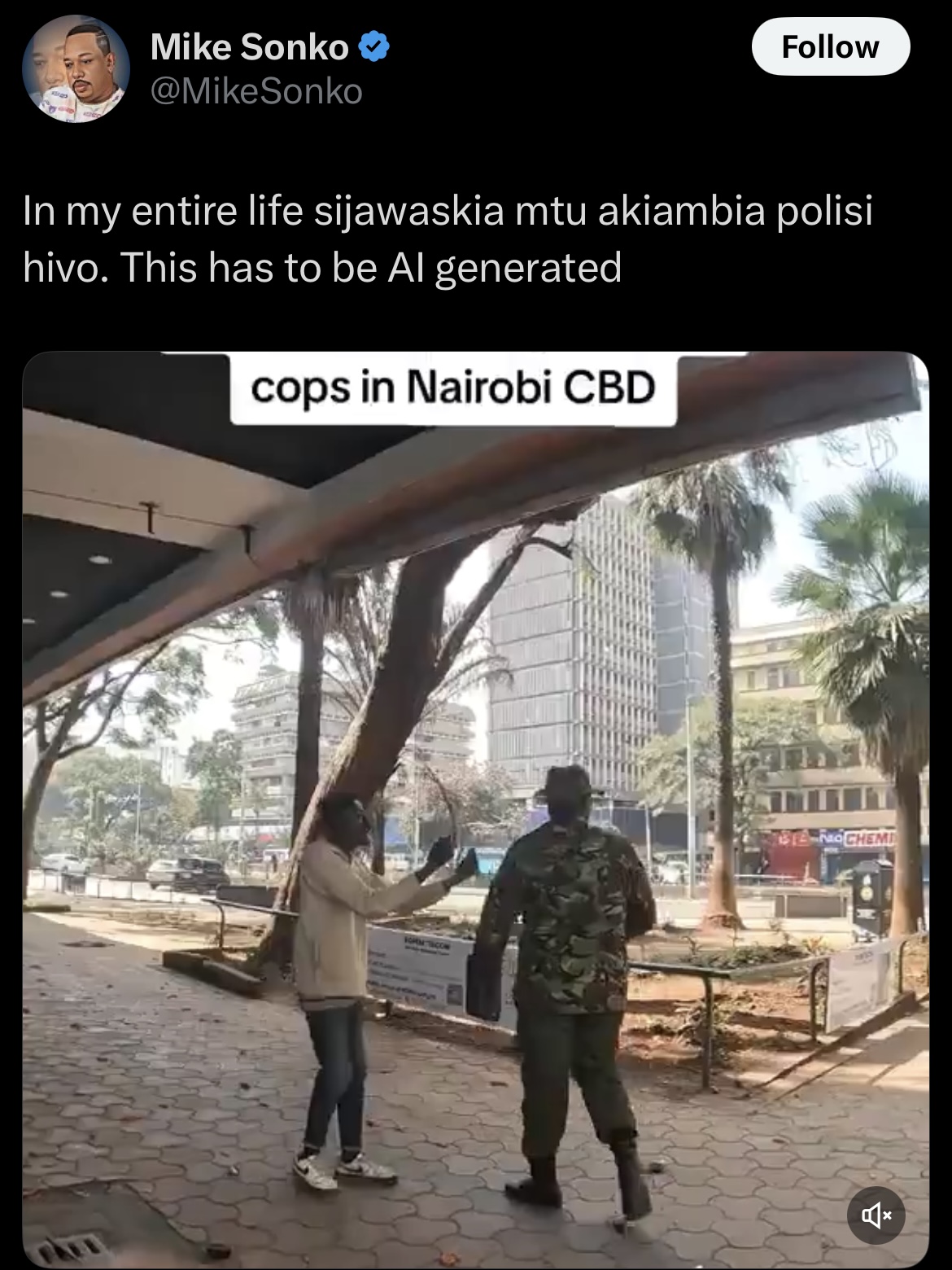
A screenshot showing Mike Mbuvi Sonko hyper-escalating a choreographed encounter between a commercial activist and a policeman
As a wash-wash operative, Mbuvi aids the government’s propaganda efforts to sustain his illicit dealings, using this staged spectacle to exaggerate threats and discourage participation. Such content, often graphic or selectively edited, portrays protests as life-threatening, reducing crowd sizes and weakening the collective power of movements.
2. Hyper-Escalating Tensions with Orchestrated Conflicts
They engage in deliberate confrontations to generate viral content, shifting focus from systemic issues like corruption or government overreach to personal dramas. Hanifa Adan has orchestrated high-profile conflicts to distract the masses.
She targeted Eric Omondi over his role in supporting the family of Albert Ojwang. Despite Omondi’s consistent philanthropy, such as raising funds for Ojwang’s family through his Sisi Kwa Sisi initiative, Adan accused him of causing chaos with a competing paybill, diverting attention from justice demands.
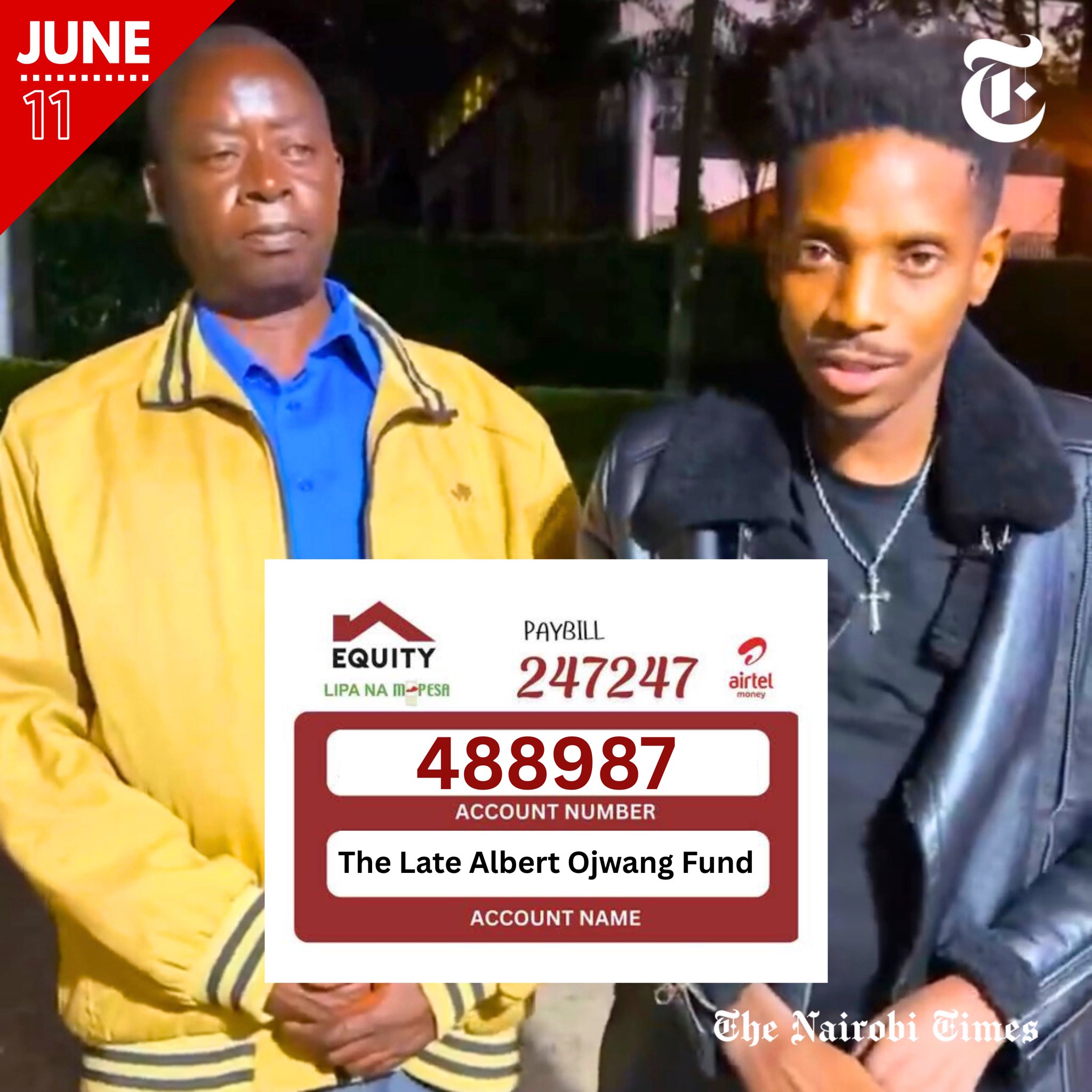
Hanifa Adan caused a scene when Eric Omondi established direct contact with Albert Ojwang’s father showing that for her, it’s all about money and clout
She then engaged in a choreographed conflict with influencer Mercy Maasai, accusing her of sleeping with married men for money, escalating personal drama on X.
Additionally, Adan launched a tirade against Bernard Kavuli, labeling him a staged plant and traitor who sold his soul after an alleged abduction on Christmas 2024.

Whether scripted or otherwise, the online spat between Hanifa Adan and Mercy Maasai was crafted to distract attention from Albert Ojwang’s murder
These orchestrated disputes, widely shared on X, hemorrhage attention from critical issues like Ojwang’s death, framing Adan as a central figure while diluting the protest narrative.
Similarly, Hussein Khalid and Marvin Mabonga, an aspiring MP for Kimilili Constituency, are seen holding unspent bullets to a camera, projecting risk while their cameramen remain at ease, shouting that police are using “live bullets.”
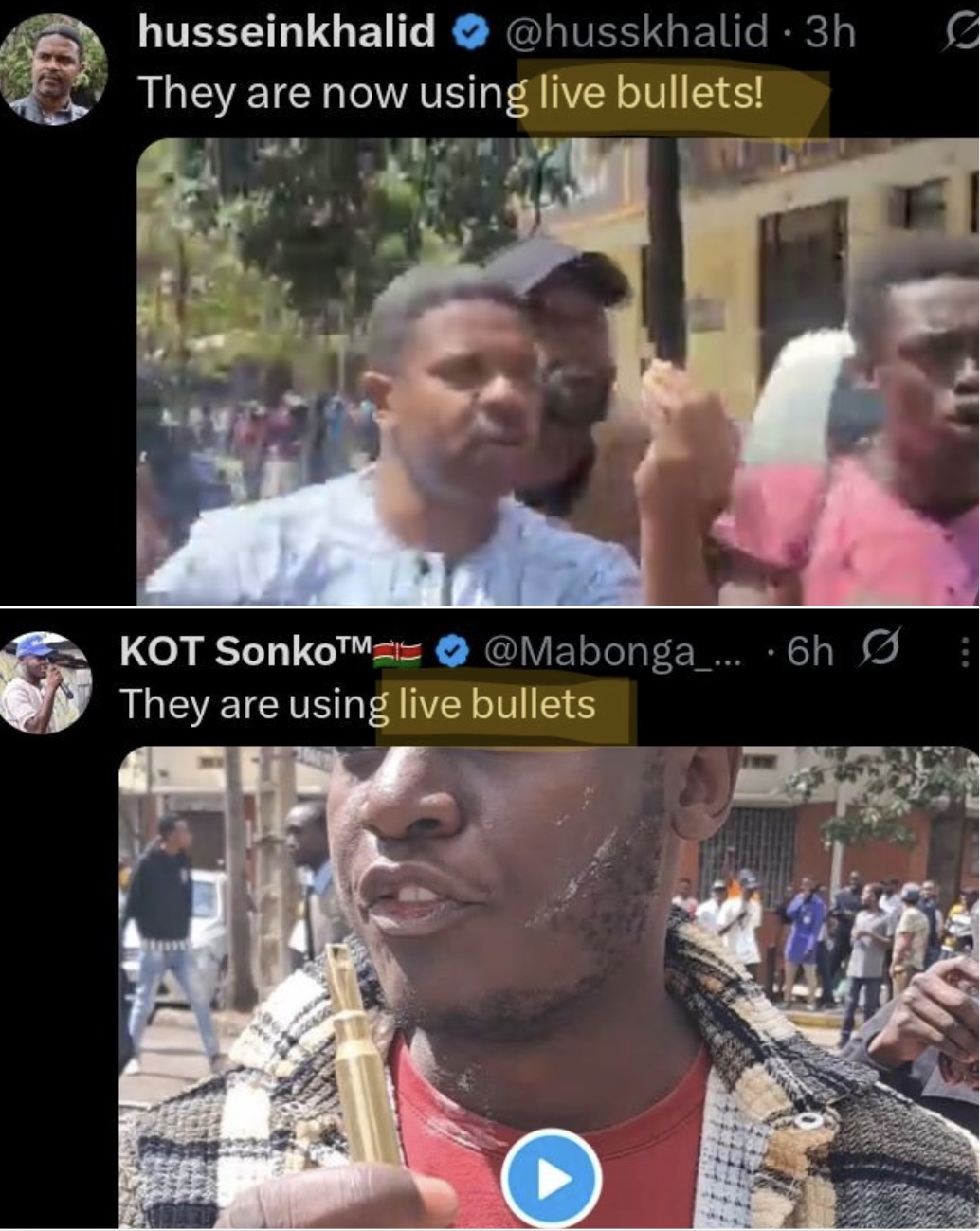
Commercial activist Hussein Khalid and Kimilili parliamentary aspirant Marvin Mabonga were paid by NIS to dramatize the discovery of unspent bullet, to spread fear and deter protests
This staged display on X exaggerates threats to deter participation.
3. Hyper-Escalating Police Presence
They amplify police presence through real-time X posts about movements, roadblocks, or arrests, creating an impression of overwhelming state control.
For instance, Shakira Wafula posted an unsolicited video on X showing fictitious police at a location, exaggerating their presence. Instead of joining Kenyans protesting on the other side of the city, her video focused on the fabricated threat, discouraging participation by portraying protests as heavily policed and futile.
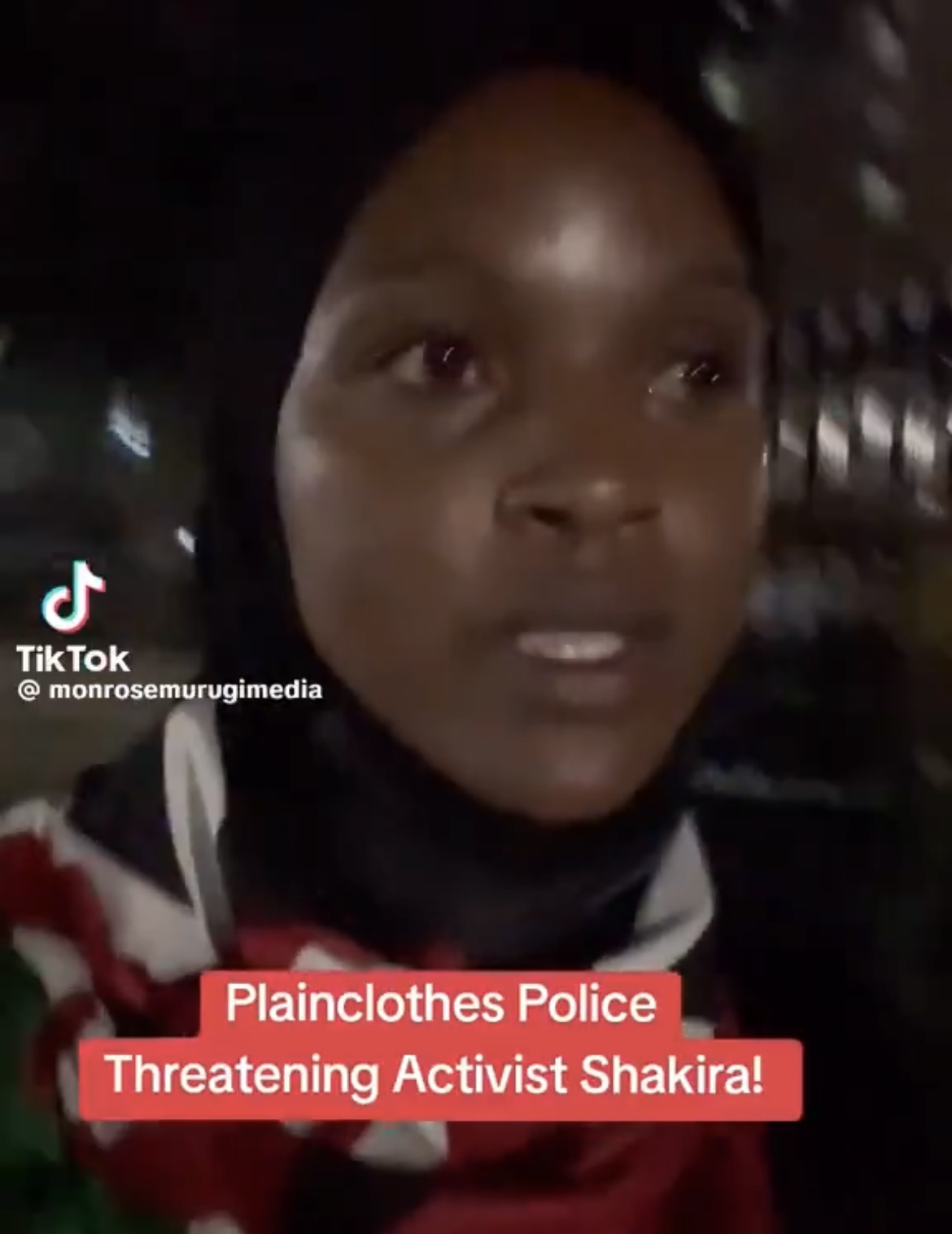
Using tone variation and facial expressions to evoke fear, commercial activist Shakira Wafula faked a story of police harassing her to drive crowds out of CBD at night
These posts, often with dramatic captions, deter potential protesters wary of surveillance or detention, shrinking participation.
4. Orchestrated Chaos: Vehicle Burnings and Staged Incidents
They are present at scenes of chaos, such as vehicle burnings or property destruction, staged to discredit protests.
Mainstream media journalist Seth Olale, who works for Citizen TV, has a direct link to the Ministry of Interior, where his former colleague Francis Gachuri serves as Communications Director, enabling him to be the first on scene when violent imagery is planted.

What a coincidence that Citizen TV journalist Seth Olale was at the scene just as the staged burning of cars begun?
For instance, Citizen TV broadcast the burning of vehicles in Nairobi CBD from one angle, while Shakira Wafula, hiding in a hotel adjacent to the burning vehicles, provided another angle on X.
Wafula’s precise timing and knowledge of the location suggest coordination, as she is on the government’s payroll, using these incidents as a fear-mongering tactic.
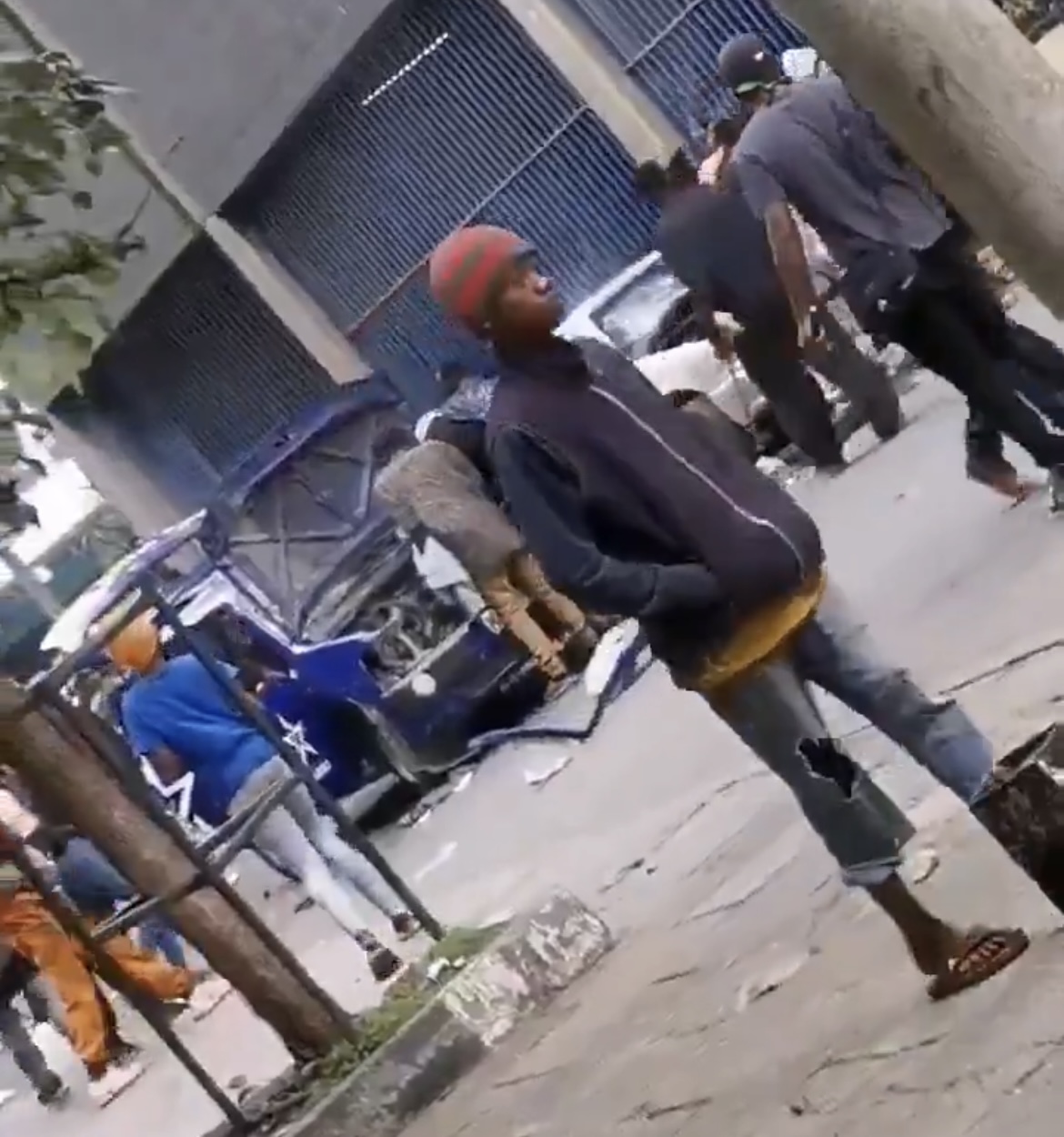
Commercial activist Shakira Wafula knew the location of the staged burning of cars, a psyop orchestrated by the Ministry of Interior
Such posts, like those from Calvince Okoth (Gaucho) highlighting similar incidents under police protection, create confusion, paint protests as violent, alienate moderate supporters, and justify harsher crackdowns by authorities.
5. Crowdfunding as a Tool for a Counter Agenda
Tanzanian-based Mwabili Mwagodi orchestrates M-Pesa fundraising campaigns where these individuals send money to each other and post screenshots on X to generate a counter-parallel agenda.
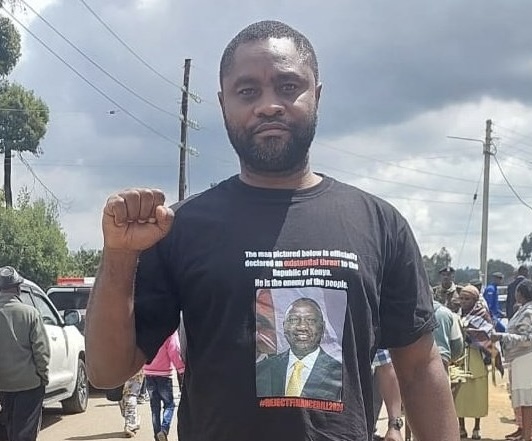
Conman and traitor Mwabili Mwagodi successfully weaponized fundraising drives where commercial activists send money to each other
In 2024, Mwagodi successfully used this tactic while masquerading as an activist against politicians platforming religion, avoiding arrest despite publicly calling out police and revealing his location, projecting a false image of defiance to mask his role as a government plant.
These campaigns, presented as support for protest efforts or medical expenses from alleged injuries, create alternative talking points that shift focus from systemic issues to personal narratives.
By publicizing these transactions, they reinforce their image as victims or heroes, diverting attention from the protest’s objectives.
6. Claiming Disproportionate Victimhood
When involved in confrontations, they frame their suffering as overshadowing the broader cause.
For example, on June 12, 2025, Wanjira Wanjiru posted on X about Joshua Okayo, who was injured during a protest, being ferried on a motorcycle to the hospital. She stated, “Police beat him with a rungu. He can’t talk and his head is twitching! There’s a police who marked him on Monday and the same police beat him today!”
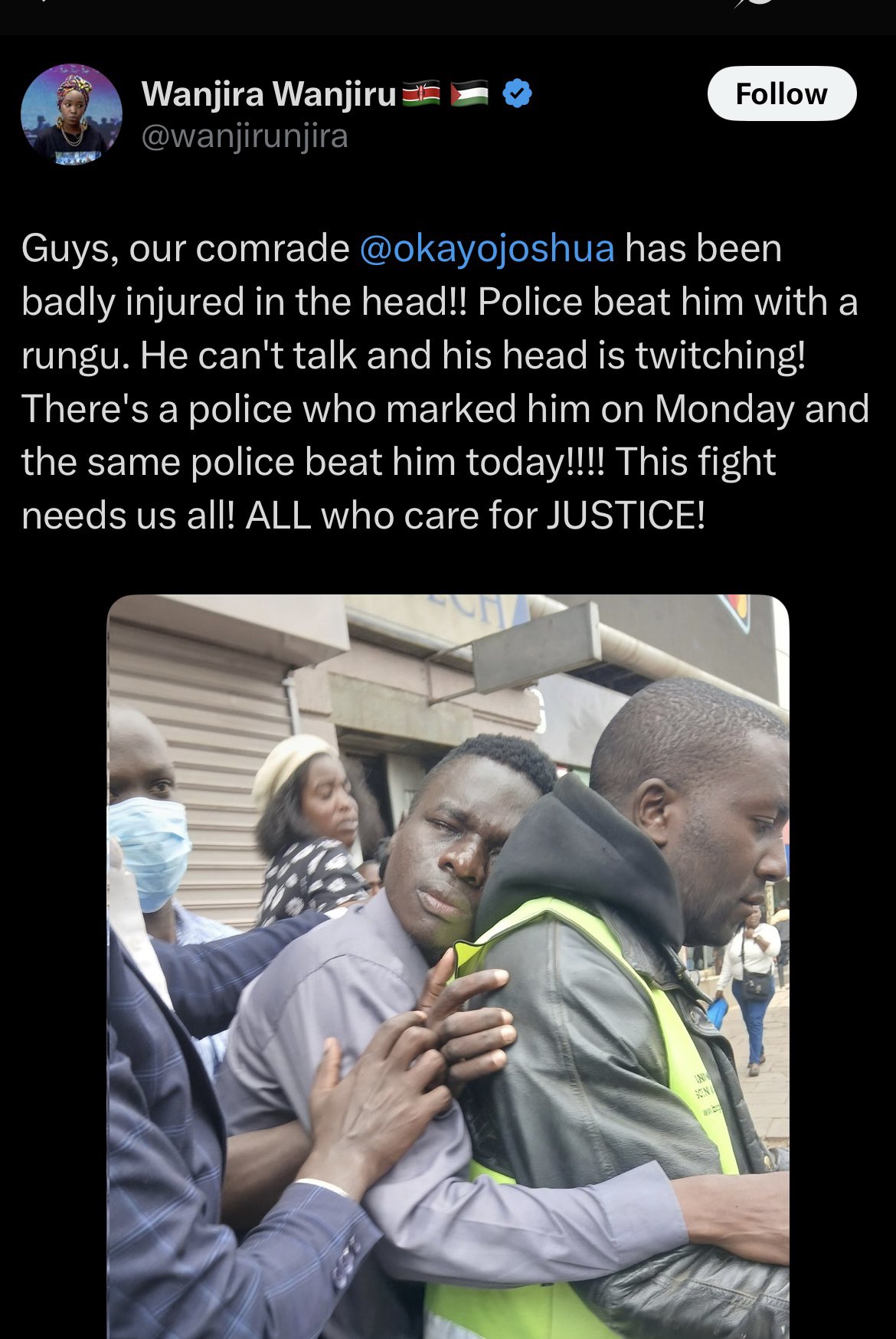
Commercial activist Wanjira Wanjiru attempts to distract attention using fraudulent impostor Joshua Okayo
This post, accompanied by a dramatic image, centered attention on Okayo’s personal ordeal, emphasizing his injuries and alleged targeting by police.
The focus on Okayo’s suffering shifted attention from systemic issues like police brutality to an individual narrative, fragmenting collective outrage.
7. Infiltration and Snitching on Youth Groups
They infiltrate youth-led protest groups to gather information and undermine efforts. By posing as allies, they gain trust, only to leak plans to authorities or rival factions, leading to arrests or disrupted protests. This erodes morale and sows distrust within activist circles, hindering effective mobilization.
8. Fear-Mongering Through Poetic Propaganda
On TikTok, Scar Poetry, known for a distinctive set of teeth, is paid to read scripts that spread fear using historical context and vivid imagery of Kenya’s forefathers’ struggles against colonialists.
These performances, designed to evoke emotional distress, exaggerate the dangers of protesting by drawing parallels to historical violence, deterring participation by framing current struggles as overwhelmingly perilous.

Instead of allowing the revolution to mature so that shared prosperity will see her afford to get braces, Scar Poetry uses her craft to reinforce oppressive narratives
The scripted nature of these posts, shared widely on TikTok, amplifies a narrative of futility and fear, undermining the momentum of grassroots movements.
9. Satanic Rituals to Instill Fear
Boniface Mwangi, sponsored by Julie Gichuru’s husband, Tony “Flash” Gichuru, performs satanic rituals by bringing coffins to protests, crafting imagery of death to deter young people from civic engagement.
This tactic, rooted in his earlier 2014 protest where he used pigs and blood in a grotesque display to summon fear through occult symbolism, exploits Kenya’s deeply religious population.

Commercial activist Boniface Mwangi uses satanic symbolism of blood, pigs and coffins to deplete the acceptability of protests
The coffins symbolize a fetish for occult practices, alarming parents conditioned by subservience to authority, who then urge their children to avoid protests. These actions, shared on X, amplify fear and discourage participation, particularly among the youth.
10. Emotional Manipulation Through Media Training
Julie Gichuru has trained these younger activists to leverage an emotional tone and facial expressions to evoke fear, a tactic she perfected as a news anchor on Citizen TV. Her broadcasts, characterized by deliberate tone variation, were crafted to keep Kenyans, particularly rural-bred audiences unfamiliar with such manipulative tactics, in a constant state of anxiety.

Queen of cringe facials and manipulative tone variations Julie Gichuru was accused of inducing mass ulcers outbreaks during her time as a screen siren, for employing deceptive and manipulative tactics
By mentoring activists to adopt similar emotional manipulation techniques, she enables them to amplify fear on X and TikTok, discouraging protest participation by sustaining a climate of unease and uncertainty.
11. Rapid Crowdfunding to Exploit Tragedies
Hanifa Adan employs a state-choreographed tactic of rapidly registering M-Pesa paybill numbers to exploit high-profile tragedies, such as Albert Ojwang’s death, to deplete public anger and distract attention.
Her swift mobilization of an X-Space and attempts to shift protest dates following Cyprian Nyakundi’s expose were calculated to project herself as a paragon of activism, redeeming her fading image and escalating her visibility.

WINDFALL: Hanifa Adan turned Albert Ojwang’s death into a money-minting undertaking
This tactic, driven by an obsession with money, serves dual purposes: it enables her to raise and potentially embezzle donations while creating a distraction that dilutes focus on systemic issues like police brutality.
By framing her fundraising as support for grieving families, Adan buys public trust, but the speed and coordination of these efforts suggest state backing to neutralize protest momentum and divert outrage into controlled, performative channels.
The Broader Impact: Entrenching Oppression Through Performative Activism
These distraction tactics have trapped Kenya in a cycle of oppression for over a decade. This bandwagon of performative activism and choreographed insurgence creates a facade that grievances are being pursued for corrective measures, but in reality, it simulates public anger to entrench systems that maintain the status quo.
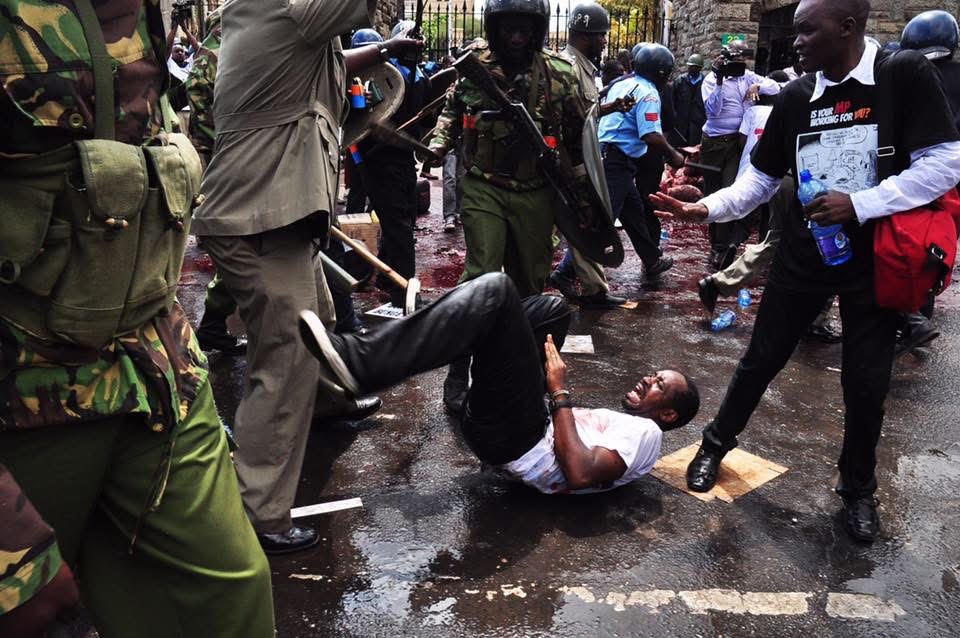
Since the advent of Boniface Mwangi’s activism in 2014, nothing has changed in Kenya. Infact things have gone from bad to worse
Since 2014, when Boniface Mwangi staged a grotesque display with pigs and blood outside parliament: a satanic spectacle meant to engineer fear, the prominence of commercial activists has coincided with the greatest erosions of freedoms, constitutionalism, and economic despair.
Their activism has added no value to Kenya’s civic space, instead enabling the state to tighten control while public outrage is diverted into staged spectacles and personal narratives.
Corrective Action
To counter the influence of these commercial activists and reclaim the protest narrative, Kenyans must take the following steps:
- Avoid Engaging in Sideshows: Refrain from participating in or amplifying the orchestrated conflicts and sensationalized content posted by these individuals on X and TikTok, as they are designed to distract from core issues.
- Do Not Contribute to Their Fundraising: Avoid sending money to M-Pesa campaigns activated by these individuals. These fundraising drives are distractions meant to shift focus from systemic grievances to personal narratives.
- Exclude Them from Communication Channels: Do not add these individuals to WhatsApp groups or engage in direct conversations with them, as they may exploit these platforms to gather information or sow discord.
- Keep Them at a Distance During Protests: Ensure these individuals are not near you during protests, as they are known to snitch on protester locations, compromising the safety and effectiveness of demonstrations.
- Evict Them from Protest Spaces: At future protests, forcefully remove these individuals from your vicinity to prevent their interference and maintain the integrity of the movement.
Conclusion: Reclaiming the Protest Narrative
Kenya’s protest movement in 2025 faces a critical juncture. The influence of these individuals on X and TikTok, through fear-mongering, orchestrated chaos, and self-centered narratives, threatens the collective struggle for justice.
Similar to how commercial activists exploited Rex Masai’s death last year, raising a staggering 31 million shillings from Gen Z protestors’ deaths, the same group of opportunistic activists is now using Albert Ojwang’s death to launch another fundraising spectacle, aiming to enrich themselves while diverting attention.
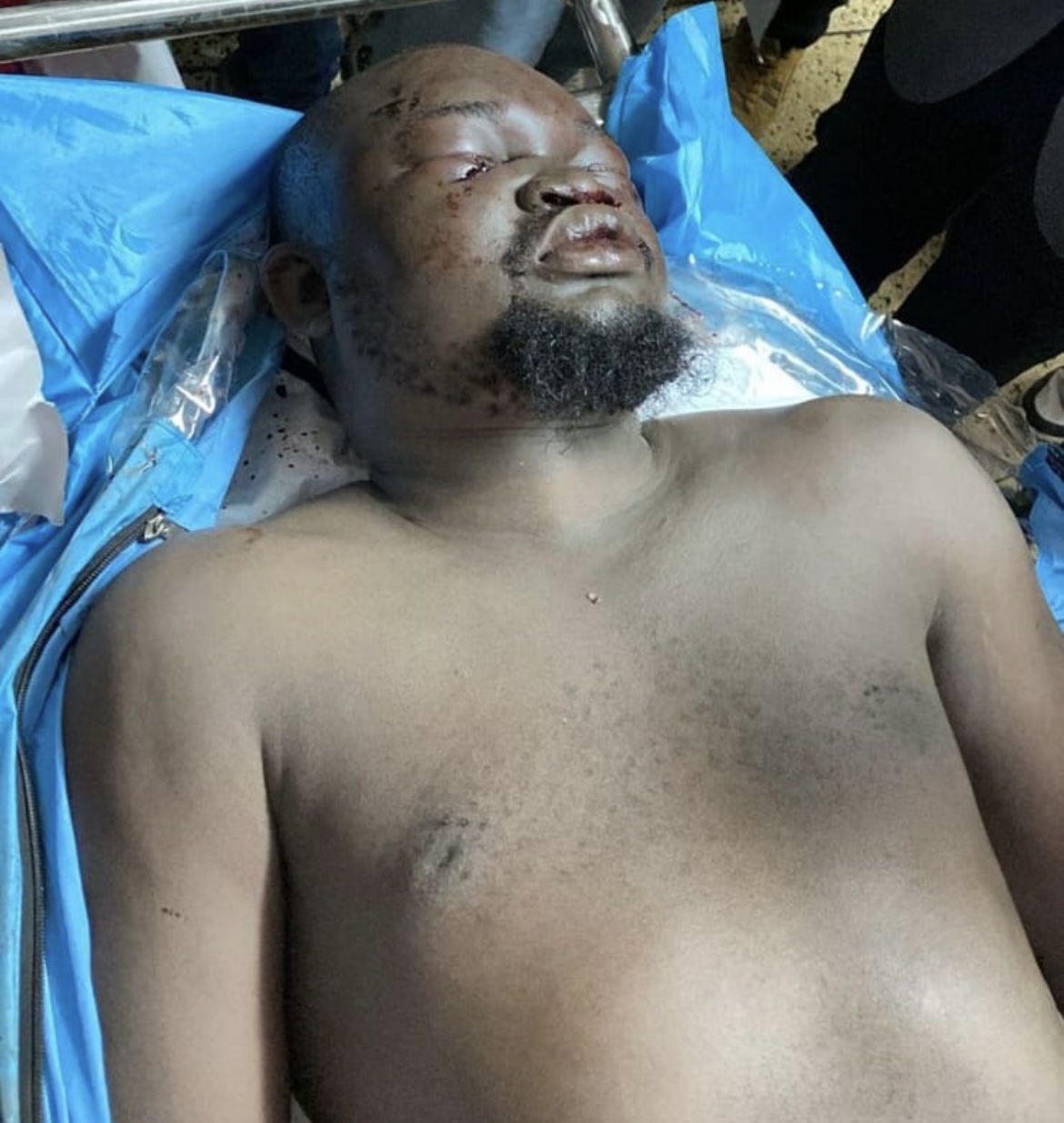
Commercial activists have shamelessly turned blogger Albert Ojwang’s death into a money-minting opportunity, exposing their depravity and mental-impotence
Genuine organizers must prioritize transparent communication, vet allies carefully, and focus on unifying messages to keep systemic issues, like the death of Albert Ojwang, at the forefront.
By implementing these corrective actions and resisting demobilization tactics, Kenyans can break the cycle of oppression and reclaim the power of their protests to drive meaningful change.
